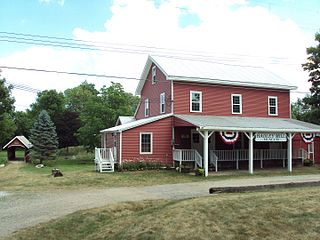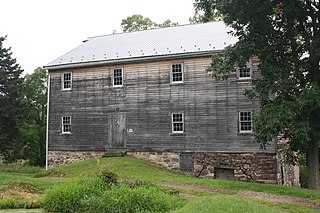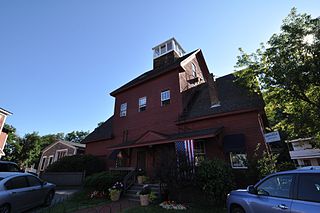
Ellendale is a ghost town in Polk County, Oregon, United States, about two and a half miles west of Dallas. It was the first White settlement in present-day Polk County. The community's name changed over the years, with the first post office in Polk County being opened in this locality as "O'Neils Mills" in 1850. The post office was renamed "Nesmiths" in 1850 and discontinued in 1852. The community was eventually renamed Ellendale.

Table Rock State Park is a 3,083-acre (12.48 km2) park at the edge of the Blue Ridge Mountains in northern Pickens County, South Carolina. The park includes Pinnacle Mountain, the tallest mountain totally within the state.

The Tuthilltown Gristmill is located off Albany Post Road in Gardiner, New York, United States. It was built in 1788, as the National Register reports, and has been expanded several times since.

George Washington's Gristmill was part of the original Mount Vernon plantation, constructed during the lifetime of the United States' first president. The original structure was destroyed about 1850. The Commonwealth of Virginia and the Mount Vernon Ladies’ Association have reconstructed the gristmill and the adjacent distillery. The reconstructed buildings are located at their original site three miles (5 km) west of Mount Vernon proper near Woodlawn Plantation in Alexandria, Virginia. Because the reconstructed buildings embody the distinctive characteristics of late eighteenth century methods of production and are of importance to the history of Virginia, the site is listed on the National Register of Historic Places despite the fact that the buildings are not original.

The Dillard Mill State Historic Site is a privately owned, state-administered property on Huzzah Creek in Crawford County, Missouri, that preserves a water-powered gristmill. The 132-acre (53 ha) site has been operated as a state historic site by the Missouri Department of Natural Resources under a lease agreement with the L-A-D Foundation since 1975. The site was listed on the National Register of Historic Places in 2015.

Price's Mill, also known as Calliham's (Callaham's) Mill, Stone's Mill, and Park's Mill, is a water-powered gristmill about 2 mi (3 km) east of the town of Parksville on South Carolina Highway 33-138 at Stevens Creek in McCormick County. Its name in the USGS Geographic Names Information System is Prices Mill. It was built in the 1890s and was named to the National Register of Historic Places on November 22, 1972. At this time, it was one of the few remaining water-powered gristmills in South Carolina.

The Newlin Mill Complex, also referred to as The Newlin Grist Mill, is a water powered gristmill on the west branch of Chester Creek near Concordville, Pennsylvania was built in 1704 by Nathaniel and Mary Newlin and operated commercially until 1941. During its three centuries of operation, the mill has been known as the Lower Mill, the Markham Mill, the Seventeen-O-Four Mill and the Concord Flour Mill. In 1958 the mill property was bought by E. Mortimer Newlin, restored and given to the Nicholas Newlin Foundation to use as a historical park. Water power is still used to grind corn meal which is sold on site. The park includes five historical buildings, which were added to the National Register of Historic Places in 1983, and 150 acres (61 ha) of natural woodland.

Carvers Creek State Park is a North Carolina state park in Cumberland County, North Carolina in the United States. Located north of Fayetteville, it covers 4,332 acres (17.53 km2) in the Sandhills region of the state. The park covers lands around Carvers Creek, a tributary of the Cape Fear River, and it borders Fort Bragg. The park is currently divided into two areas, Long Valley Farm and the Sandhills Property. The park is still being planned, and the state is planning to acquire more land for the park.

The Hadley Flour and Feed Mill is located at 3633 Hadley Road in rural Hadley Township in southwestern Lapeer County, Michigan. It was designated as a Michigan State Historic Site and also added to the National Register of Historic Places on September 25, 1986.

Springfield Mill, also known as the Piper-Streeper Mill, is a historic gristmill located along the Wissahickon Creek in Erdenheim, Springfield Township, Montgomery County, Pennsylvania. It is a building on the Bloomfield Farm tract, now part of Morris Arboretum.

Guldin Mill, also known as Lauer's Mill, is a historic grist mill and national historic district located in Maidencreek Township, Berks County, Pennsylvania. The district encompasses one contributing building and one contributing site. The combined house and mill was built in two sections. The house was built in 1781 and the mill in 1822. It is a 2 1/2-story, stone building measuring 42 feet by 80 feet. Also on the property are the watercourses, consisting of the headrace, two ponds, and tail race. The mill operated into the 1950s. Local children believed this to be a nudist colony. It was listed on the National Register of Historic Places in 1990.

Yoder Mill, also known as Renninger Mill, is a historic grist mill located in Pike Township, Berks County, Pennsylvania. The mill was built in 1796, and is a 2 1⁄2-story, frame building measuring 41 feet by 50 feet. It sits on a stone basement. It was rebuilt in 1885 after a fire. Also on the property is a contributing 2 1⁄2-story, stuccoed stone miller's house the headrace and millpond. The merchant mill ceased operation in the 1940s.

Champion Mill is a historic flour and feed mill in Champion, in the southwestern part of the state of Nebraska, in the Midwestern United States. Built in 1888 and rebuilt in 1892 after a fire, the mill was used commercially until 1968. It is now a museum and park run by Chase County preserving the state's last working water-powered mill. The mill, headrace, and dam were added to the National Register of Historic Places as a historic district in 1988.

The Hagood-Mauldin House is a property listed on the National Register of Historic Places located in Pickens, South Carolina. The house was originally constructed for James Earle Hagood ca.1856 in the town of Old Pickens but in 1868 when the Pickens District was divided into Oconee County and Pickens County, the house was disassembled, boards and beams numbered, and reassembled at its present location in the town of Pickens.

The Ashland Gristmill and Dam are a historic former industrial facility in the heart of Ashland, New Hampshire. Built in 1903 on the site of an older mill, the gristmill demonstrates the continuing viability of wood framing for mill buildings in an era when it had become uncommon. The property was listed on the National Register of Historic Places in 1979. It has been converted to professional offices.

Sheriff Mill Complex, also known as Sheriff Place, is a historic grist mill complex located near Easley, Pickens County, South Carolina. The complex includes a main house, gristmill, miller's house, millpond, and dam. They date to the late-19th and early-20th centuries. The grist mill was built in 1881, and is a 1 1/2-story, frame structure. It remained in operation until 1955. The main house was built about 1898-1899, and is a two-story, frame I-house with a rear ell.

Dellinger Mill is a historic grist mill located near Hawk, Mitchell County, North Carolina. It was built about 1901-1903, and is a small unpainted rectangular frame building. It measures 18 feet by 14 feet, 6 inches, and is sheathed in chestnut boards and weatherboard. It has a 23 feet in diameter water wheel that was rebuilt in the 1940s. Other contributing resources are an apple house and the mill site. The mill operated until 1955 and was restored after 1997. It is the last water powered/stone ground grist mill of its kind left in the state of North Carolina.
























